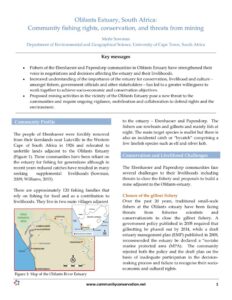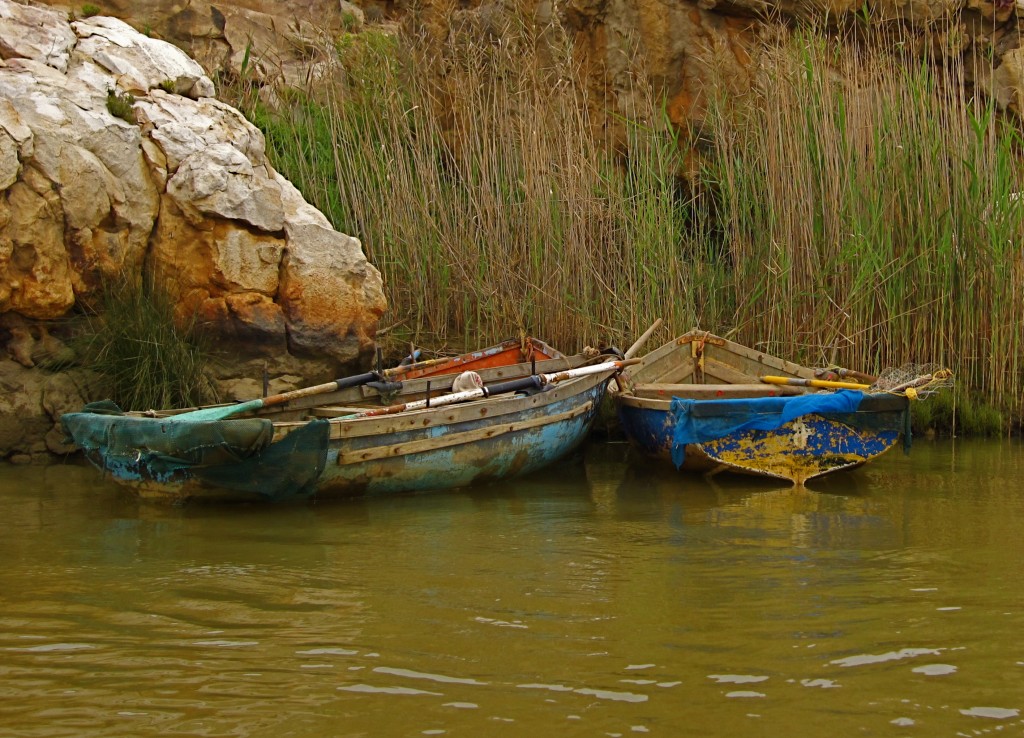
14 Jan Olifants Estuary, South Africa
Merle Sowman
Key messages
• Fishers of the Ebenhaeser and Papendorp communities in Olifants Estuary have strengthened their voice in negotiations and decisions affecting the estuary and their livelihoods.
• Increased understanding of the importance of the estuary for conservation, livelihood and culture — amongst fishers, government officials and other stakeholders — has led to a greater willingness to work together to achieve socio-economic and conservation objectives.
• Proposed mining activities in the vicinity of the Olifants estuary pose a new threat to the communities and require ongoing vigilance, mobilisation and collaboration to defend rights and the environment.
Community profile
The people of Ebenhaeser were forcibly removed from their farmlands near Lutzville in the Western Cape of South Africa in 1926 and relocated to unfertile lands adjacent to the Olifants Estuary (Figure 1). These communities have been reliant on the estuary for fishing for generations although in recent years reduced catches have resulted in many seeking supplemental livelihoods(4,5).
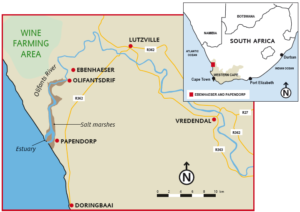
Figure 1: Map of the Olifants River Estuary
There areapproximately 120 fishing families that rely on fishing for food and as a contribution to livelihoods. They live in two main villages adjacent to the estuary – Ebenhaeser and Papendorp. The fishers use rowboats and gillnets and mainly fish at night. The main target species is mullet but there is also an incidental catch or “bycatch” comprising a few linefish species such as elf and silver kob.
Conservation and livelihood challenges
The Ebenhaeser and Papendorp communities face several challenges to their livelihoods, including threats to close the fishery and proposals to build a mine adjacent to the Olifants estuary.
Closure of the gill net fishery
Over the past 20 years, traditional small-scale fishers at the Olifants estuary have been facing threats from fisheries scientists and conservationists to close the gillnet fishery. A government policy published in 2005 required that gillnetting be phased out by 2014, while a draft estuary management plan (EMP) published in 2008, recommended the estuary be declared a no-take marine protected area (MPA). The community rejected both the policy and the draft plan on the basis of inadequate participation in the decision-making process and failure to recognise their socio-economic and cultural rights.
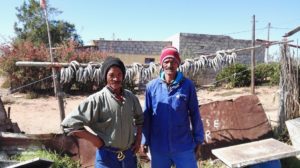
Figure 2: Two of the older fishers from Olifantsdrif with dried fish (bokkoms) in background
Proposed mining adjacent to the estuary
In April 2016, an Australian mining company, with various subsidiaries in South Africa, submitted a mine prospecting application for heavy mineral sands, including zircon, phosphates, garnet, precious stones and diamonds on two farms that lie adjacent to the north bank of the Olifants Estuary. The proposed mining area is located on land identified as a critical biodiversity area. The southern boundary of the mining area borders on the sensitive Olifants estuary and associated habitats (approximately 15 km in extent) while the western boundary is adjacent to the seashore and extends northwards for approximately 18 km. To the north of the proposed mining area an existing mine is currently operating under the same Australian company.
Fishers at the Olifants estuary, as well as other community members, are particularly concerned about the negative impacts that the proposed mining activities may have on estuarine habitats, water quality and sediment movement as well as scenic views and sense of place. Of particular concern is its effect on local livelihoods and plans for conservation as well as a community tourism development at the mouth of the estuary.
Although the Basic Assessment Report (BAR) for the prospecting phase has indicated that no drilling of experimental holes will take place on the estuary banks(3), fishers are concerned that once approved, environmental controls will be ignored. Fishers are also concerned that should prospecting yield favourable results and mining be approved, the company will request permission to extend the mining operation into the estuary and out to sea, as it happened at the existing mine site.
The lack of accessible information, consultation and transparency associated with the initial basic environmental assessment process led civil society to submit objections questioning the integrity of the process and the initial assessment report. Despite these objections, the Minister approved the report, which led to a formal appeal procedure in 2018 where fishers, with support from their local partners, raised objections to shortcomings in the public participation process and the quality of the assessment report. Two of the appeals were upheld by the Minister of Environmental Affairs and the applicant was required to undertake further public consultation and prepare a biodiversity assessment of the estuary. However, a revised report has not changed the fisher community’s steadfast opposition to mining in the area.
Although there is a policy and legislative framework in place to regulate the mining sector, the increasing power of that sector in South Africa (with strong political backing), presents a serious threat to coastal communities like those living adjacent to the Olifants estuary. The people of Ebenhaser and Papendorp are facing threats to their livelihoods and way of life – this time due to mining proposals.
Community initiatives
Working with their community partners, the Olifants Estuary fishing communities are addressing the challenges facing their community.
Challenging threats to close the gillnet fishery
The Olifants fishing communities collaborated with partners (University of Cape Town, Masifundise Development Trust and the Legal Resources Centre) to challenge proposals to close the fishery and instead developed an alternative vision and set of fishery management proposals for the estuary. The proposals recognise the fishers’ rights to resources, while addressing conservation and fisheries management objectives.
Based on longstanding local and scientific knowledge, as well as extensive deliberations amongst fishers and their social partners over a four-year period, the fishers’ proposals were presented to the Olifants Estuary Management Forum, a group of representatives from relevant government departments, local famers, fishers and other interested parties, in November 2013. The EMP was consequently revised to address the rights and interests of the fishing and land claimant communities. The deliberations and negotiations amongst estuary rights-holders and stakeholders have enhanced understanding and trust amongst different stakeholders, providing an enabling environment to advance efforts to achieve sustainable livelihoods and conservation objectives(1).
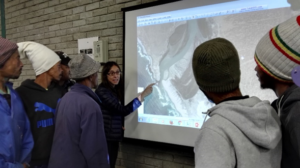
Figure 3: Discussing the boundaries of the Community Conservation Area at a meeting of fishers with social partners, in Ebenhaeser, June 2016
A key success to the finalisation of the EMP was a decision to establish a community conservation area (CCA) at the mouth of the estuary that would be co-managed with local community members. While progress has been slow to formalise the CCA, significant progress has been made in bringing different groups together including representatives of the land claimants, fishers, conservation authorities and other estuary stakeholders, to discuss and define the boundaries of the CCA, seek agreement on traditional land use practices on land adjacent to the protected area (i.e. grazing of sheep on the salt marshes during periods of drought) and to develop maps demarcating the area. The next steps in the process include: i) examining various legal entities for formalising the CCA; ii) clarifying the roles and responsibilities of fishers and conservation officials in the co-management arrangement; and iii) identifying community members to participate in a conservation training programme.
While there is renewed support from various conservation agencies to accelerate the process to declare a conservation area at the mouth of the estuary, especially with the threat of mining, the process has been slow due to institutional blockages.
Challenging the mining proposition
Fishers of the Olifants Estuary are once again forced to mobilise the community, and enlist support from researchers, NGOs and CSOs to address the new threat. The recent events highlight the power of mining interests, and confirm that certain departments (mining) wield more power than others (environment) and are still working in silos, pursuing their sectoral mandates without due consideration of the context and the rights and interests of local communities. Once again, it rests on the poor and marginalised to be vigilant and find ways of tackling proposals that could undermine the ecological integrity of the system, their livelihoods and way of life. Clearly, the partnerships that have developed over the years between the local fishers, researchers and NGOs have enhanced their capacity and agency to engage with traditionally powerful actors and challenge decisions that affect their rights.
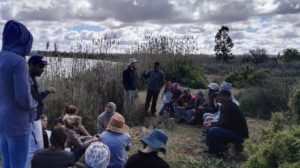
Figure 4: Fishers, university researchers and students meeting together on the banks of the Olifants estuary (September 2016)
Legal recognition of fishing communities
Between 2016 and 2019, the fisheries authority, the Department of Agriculture, Forestry and Fisheries, began putting in place procedures to implement the Small-scale Fisheries Policy promulgated in 2012(1). The policy recognises small-scale fishers as a legal category of fishers and commits to protect their rights, give preferential access to coast- dependent communities and provide support to develop this new sector.
The development and promulgation of the new policy and set of regulations was seen as a victory for small-scale fishers who have been struggling to gain legal access to resources traditionally harvested since the advent of democracy in 1994(2) . However, implementation of the policy is proving complex and challenging, as many thousands of fishers find themselves excluded from the process due to stringent criteria developed by the national government which determines who is qualified or not as a bona fide small-scale fisher.
Some of the traditional fishers of the Olifants Estuary have been left off the official ‘list’ of those qualifying for long-term fishing rights to resources in the Olifants Estuary. Ongoing work to challenge government decisions regarding who gains access to resources continues.
Thus, despite a new policy which seeks to recognise and protect small-scale fishers and communities, fishers, such as those living at Ebenhaeser and Papendorp, fishers are at risk of being marginalised due to complex administrative procedures, a legalistic approach to interpreting the new regulations, inadequate communication with government, and lack of capacity and skills at the local level to challenge complex state governance systems alone. These challenges, together with the new threat of mining, highlight the ongoing vulnerability of coastal fishing communities in South Africa, and the importance of building networks and partnerships to challenge unfair decisions, tackle complex administrative procedures and defend local rights.
Practical Outcomes
• A much greater appreciation of the rights and interests of different users and stakeholders in the Olifants fishery has emerged, which has been useful in discussions with the government regarding future management of the estuary and fishery.
• Increased understanding amongst fishers and government officials of the importance of the estuary for conservation, livelihoods and culture and an initiative to declare a community conservation area at the mouth of the estuary.
• A greater willingness amongst fishers and conservation agencies to work together in a co-management arrangement to achieve livelihood and conservation objectives.
• Increased capacity and empowerment of fishers to challenge unjust proposals, plans and policies and participate in planning and decision-making processes.
• Revision of the Olifants Estuary Management Plan to include fisher’s proposals for management of the fishery.
• The gillnet fishery has not been closed despite government’s intention to close it at end of 2014.
• Strengthening of partnerships between fishers, university researchers and other social partners.
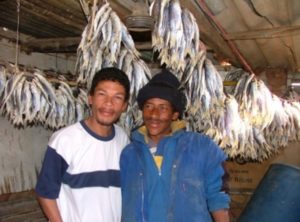
Figure 5: Two fishers with their dried fish catch (locally known as “Bokkoms”)
References
- Republic of South Africa, Department of Agriculture, Fisheries and Forestry (RSA DAFF) (2012). ‘Policy for the Small-scale Fisheries Sector in South Africa’. Government Gazette 35455, 20 June 2012. Pretoria, South Africa. Available at: https:// www.nda.agric.za/docs/policy/policysmallscalefishe.pdf
- Republic of South Africa, Department of Agriculture, Fisheries and Forestry (RSA DAFF) (2016) Regulations relating to Small Scale Fishing GNR 229 GG No. 39790, dated 8 March 2016.
- Sowman, M. (2017). ‘Turning the tide: strategies, innovations and transformative learning at the Olifants estuary, South Africa’. In: D. Armitage, A. Charles and F. Berkes (eds.). Governing the Coastal Commons: Communities, Resilience and Transformation, Chapter 2, pp. 25–42. Earthscan Routledge. Available at: https://doi. org/10.4324/9781315688480
- Sowman, M. (2009). ‘An Evolving Partnership: Collaboration between ‘experts’ and a net- fishery’. Gateways: International Journal of Community Research and Engagement 2: 119–143. Available at: https://doi.org/10.5130/ijcre.v2i0.1174
- Williams, S. (2013). ‘Beyond rights: Developing a conceptual framework for understanding access to coastal resources at Ebenhaeser and Covie, Western Cape, South Africa’. Doctoral thesis (Environmental and Geographical Science). Department of Environmental and Geographical Science, University of Cape Town, South Africa. Available at: https:// open.uct.ac.za/bitstream/handle/11427/4819/thesis_ sci_2013_williams_samantha.pdf?sequence=1&isAllowed=y
Acknowledgements
The author acknowledges the involvement of various fishers of Olifants Estuary as well as students from the University of Cape Town who have participated in research and development work with fishers of the Olifants Estuary over the past few years: Nico Waldeck, Jackie Sunde, Serge Raemaekers, Samantha Williams, Wayne Rice, Nadine Soustchka and Tayla Louw. The involvement of NGOs, such as Masifundise Development Trust and the Legal Resources Centre, have been critical to challenging unjust government decisions and building capacity amongst fishers in their quest for recognition and respect of their rights.



